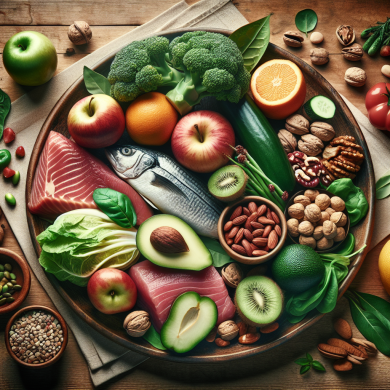### Paleo-Friendly Grocery Shopping: Essential Tips Unveiled
“`html
Paleo-Friendly Grocery Shopping: Essential Tips Unveiled
Adopting the paleo diet, often referred to as the “caveman diet,” entails embracing a nutritional approach that mirrors the dietary habits of our Paleolithic ancestors. This involves consuming whole, unprocessed foods that were available before the advent of agriculture. While the concept sounds simple, executing it in today’s complex food landscape can be challenging. This article will guide you through essential tips for paleo-friendly grocery shopping, ensuring your pantry aligns with your health goals.
Understanding the Paleo Diet
Before diving into shopping tips, it’s crucial to understand what the paleo diet entails. The core principle is to consume foods that our hunter-gatherer ancestors would have eaten, such as:
– Lean meats (preferably grass-fed or wild-caught)
– Fish and seafood
– Fresh fruits and vegetables
– Nuts and seeds
– Healthy fats and oils (like olive oil, coconut oil, and avocado oil)
The diet excludes processed foods, grains, legumes, dairy, refined sugars, and artificial additives. Knowing this foundation is the first step in making informed decisions while grocery shopping.
Planning Your Paleo Shopping List
A successful grocery trip begins with a well-thought-out shopping list. Here are some crucial elements to consider:
1. Prioritize Protein
At the heart of the paleo diet is high-quality protein. Focus on sourcing:
– Grass-fed beef and lamb
– Free-range poultry
– Wild-caught fish and seafood
– Pasture-raised pork
These options provide essential nutrients like omega-3 fatty acids and are more humane and environmentally friendly than conventional meat products.
2. Fill Your Cart with Vegetables
Vegetables should form the bulk of your diet. Opt for:
– Leafy greens (spinach, kale, Swiss chard)
– Cruciferous vegetables (broccoli, cauliflower, Brussels sprouts)
– Root vegetables (sweet potatoes, carrots, beets)
– Seasonal and local produce for maximum freshness and nutrient density
3. Select Fresh Fruits Wisely
While fruits are a staple in the paleo diet, they should be consumed in moderation due to their natural sugar content. Choose:
– Berries (blueberries, strawberries, raspberries)
– Apples and pears
– Citrus fruits (oranges, lemons, limes)
– Stone fruits (peaches, plums, cherries)
4. Incorporate Nuts and Seeds
Nuts and seeds are excellent sources of healthy fats and protein. Consider:
– Almonds, walnuts, and cashews
– Sunflower seeds, pumpkin seeds, and chia seeds
– Nut butters without added sugars or oils
Remember to consume them in moderation, as they are calorie-dense.
5. Embrace Healthy Fats and Oils
Fats are a crucial energy source in the paleo diet. Stock up on:
– Extra virgin olive oil for salads and low-heat cooking
– Coconut oil for high-heat cooking and baking
– Avocado oil for its neutral flavor and high smoke point
– Ghee (clarified butter) as a lactose-free option
Strategizing Your Shopping Experience
Navigating the grocery store with a clear strategy can help you make the most of your shopping trip.
1. Shop the Perimeter
Most grocery stores are designed with fresh produce, meats, and dairy around the perimeter. Focus your attention here, as these sections contain the majority of paleo-friendly options.
2. Read Labels Diligently
Even seemingly healthy products can contain non-paleo ingredients. Always read labels to check for hidden sugars, preservatives, and additives. Look for items with minimal ingredients, all of which should be recognizable and natural.
3. Opt for Organic and Non-GMO
When possible, choose organic and non-GMO products. This is particularly important for produce, meats, and eggs, as they are less likely to contain harmful pesticides and additives.
4. Buy in Bulk
Purchasing items like nuts, seeds, and dried fruits in bulk can be cost-effective. Ensure they are free from added sugars and oils.
5. Explore Local Farmers’ Markets
Farmers’ markets are treasure troves for fresh, local, and often organic produce. Building relationships with local farmers can provide insight into how food is grown and harvested, ensuring it aligns with paleo principles.
Overcoming Common Paleo Shopping Challenges
While shopping paleo can be straightforward, certain challenges may arise. Here’s how to tackle them:
1. Budget Constraints
Eating paleo can sometimes be more expensive, but it doesn’t have to break the bank. Prioritize essential items and look for sales, discounts, and generic brands that meet paleo criteria. Buying seasonal produce and less expensive cuts of meat can also help reduce costs.
2. Time Management
Shopping for and preparing whole foods can be time-consuming. To streamline the process, dedicate time each week to meal planning and prep. Batch cooking and freezing meals can save valuable time during busy weeks.
3. Avoiding Temptations
Grocery stores are often filled with tempting non-paleo options. To avoid straying from your diet, eat a meal or snack before shopping to reduce hunger-driven purchases. Stick to your shopping list and avoid aisles with processed foods.
Conclusion
Paleo-friendly grocery shopping requires a combination of knowledge, strategy, and discipline. By understanding the principles of the paleo diet and adhering to the tips outlined in this article, you can successfully navigate the grocery store, ensuring your kitchen is stocked with nutritious, paleo-compliant foods. With practice, these shopping habits will become second nature, supporting a healthy and sustainable lifestyle in line with your evolutionary heritage.
“`















Add comment